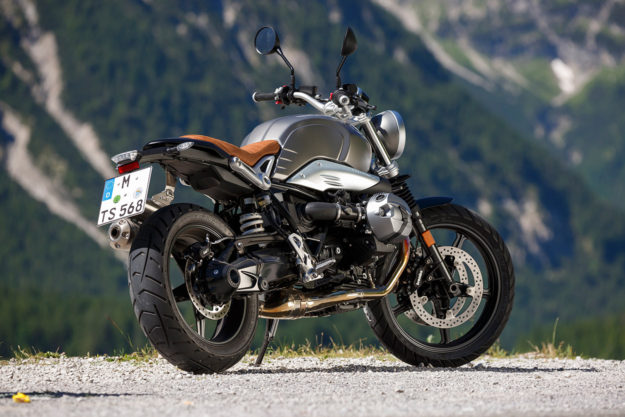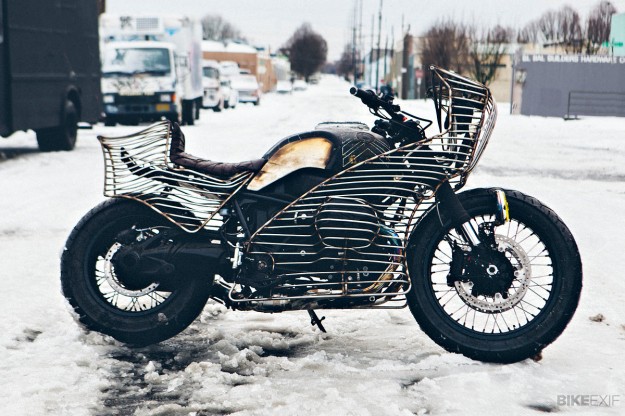
Sometimes with radical results: like El Solitario’s infamous ‘Impostor.’
Ola: At first everyone hated ‘Impostor.’ And it was so controversial. Then after a year, I saw it start popping up again, and then it totally changed. Everyone said, “That bike is so cool, it changed the whole custom scene, it’s so bold—and it’s so bold that BMW dared to do this.” And now this is the bike that everyone remembers, right?
Thrass: It’s basically a reflection, it’s a mirror of who they are. And this is what is so interesting to us—you look at a website like yours, and you look at all these bikes, and constantly see the reflection of that person.
Look at the Japanese guys, who have also done bikes with the nineT—absolutely amazing! You see how awesome the Japanese culture is, the craftsmanship, how these bikes are put together (below). Completely different, for example to how David [Borras, El Solitario] works, or how Rough Crafts works, or how a guy in the United States works.
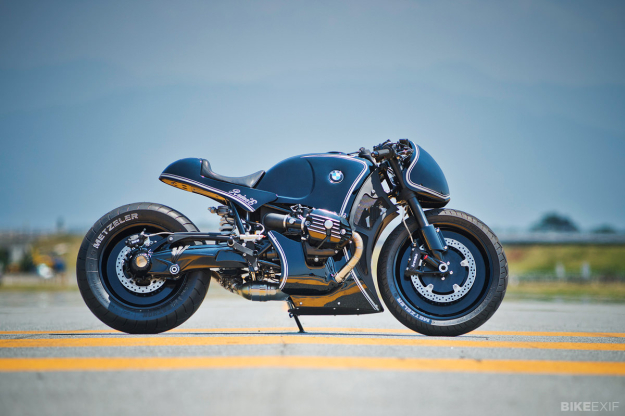
It’s easy to criticize design decisions on an OEM bike—but people often don’t realize the boxes you have to tick to get a bike through production. What’s it like navigating that when you’re developing a bike like the R nineT?
Ola: We first checked all the things that a customizer wants to do, and what we’d wanna do. For example, we took the GS swing arm, because it has the mounts for the little rear fender thingy—but we wanted to use this bolt pattern, so that you can put a side-mounted plate on it. And also make sure that it’s super easy to take off the number plate, because that’s what everyone does. Then of course our guys go, “But then you make it illegal.” But that’s what people do.
So that’s how we attacked everything on that bike, really thinking from our garage point of view, like what do you wanna do with the bike? Then we have to make sure that we don’t create problems when they do it. Like not cutting the rear frame—that was a big thing.
Roland: We, as Germans, know the term ‘over engineering.’ So you really have to take care, because from one side, the development guys say “we have this system here, and this assistance, and this control system, and…” Well, this maybe fits a GS or a double-R, but not an R nineT. Of course you have to have ABS, which is a good thing, but then you have so many other things that can make the bike complicated.
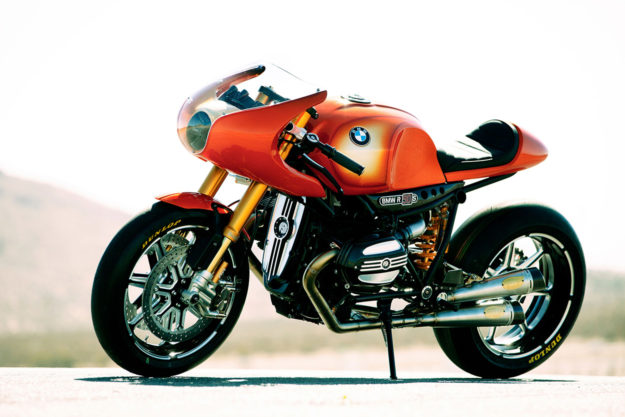
Let’s talk about the Concept 90 (above). That was an interesting bike to release before the R nineT.
Ola: But it’s actually quite easy to build one, out of the nineT.
And now you have the Scrambler.
Ola: We wanted to bring it back to how the old school bikes actually used to work. You have one base bike: you jack it up and you have a scrambler, you tuck it down and put a fairing on it and you have a cafe racer.
So it’s a super simple base that you very quickly and very easily can turn into other bikes. And this is gone now—every bike is so complicated, it’s so targeted to the audience, and measurable, that you can’t do that any more.

So why a racer as the first concept?
Ola: We sat down with Roland Sands and we talked, after he rode it—because first we had to convince him…
Roland: [laughs] I think for him, when he found out the performance…
Ola: …he didn’t know what this bike was. We said, “We have a cool bike, we think we can build a really cool concept out of this, we can do it together.” We talked for years about doing a bike together, but of course it was still so secret.
So we brought the bike to him, and the first time he test rode it, he basically started with a burnout. There was no in-between. He just sat on the bike, first gear, braaaap, and he went out in the street. And we just heard him revving the shit out of the bike, back and forth a couple of times, then he came back into his little back yard, and just started doing stand up donuts. We were just looking at each other like: “I think he likes it.”
So when we sat down and talked around the bike, we thought: he’s from California, we’re from Germany. The last time a collaboration like that was really fruitful was with the race bikes, and basically became the R 90 S (below).

You teased the Scrambler with the Path 22 ‘concept’ at Wheels & Waves. But the final bike was actually very close to the concept.
Ola: The Scrambler was, of course, already done. It was already in testing.
The funny thing was the exhaust. A lot of guys thought, “If this is coming, it won’t get that exhaust—Akrapovič is way too expensive.” And now it’s on there.
Roland: When I did the exhaust for the first R nineT, I drove to Slovenia, to Akrapovič, with one of the prototypes in the back of the van. We spent two days in the garage, cutting tubes and finding the way. And they loved it, that way of working. They said “This is so great, because usually it’s about PowerPoint and CAD—but we are a physical company, we really want to cut steel and weld and do stuff.” I said “I’m the same, so let’s do it the old school way!”
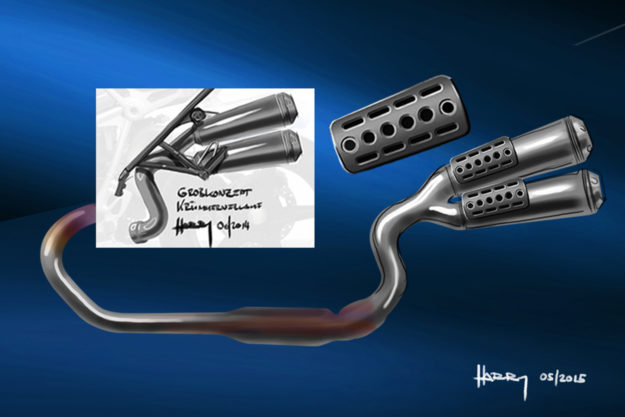
Then the Scrambler was the new project. The Akrapovič people came to Munich, and they had the meeting with our engine guys, and the engine guys gave them CAD and PowerPoint and all these things.
After the meeting, I said: “Look, you’re doing a scrambler. You are the exhaust experts, you know what a scrambler means for an exhaust. It’s defined by the exhaust, it’s so important. Just look at the legacy, look at the internet, and do a hardware sample.”
A couple of weeks later they had this exhaust for the Path 22. This is such a great company, they’re so talented, they have the right guys, and they have this idea of how to do it.

When we spoke to you about the Path 22 last year, and asked if you planned to expand the R nineT line, you said, “We’d be fools not to.”
Ola: All these old-school bikes were kinda built up the same way. You had scramblers and cafe racers, and they were all based on whatever bike you had. They didn’t start making new frames, or new motors, just because they made a scrambler, right? They just jacked it up, and kept it simple. So we were just brainstorming what you could do.
Thrass: We were looking at what we could actually build out of that architecture. And it was, at the time, actually very difficult to convince the management that this was the right way to go. Because, again, you’re looking at a different way of creating products.
Ola: And the nineT wasn’t even out when we started, so there weren’t any numbers or sales figures.
So how did you know that ‘scrambler’ was going to be the right style for the time?
Ola: If you’re in the scene and you really have wide-open radar for what’s going on, you can pick up things. If they’re gonna hit or not? Of course you don’t know. But you can do the best you can, and you can predict things.
And a lot of it is like Thrass says—you can’t back it up with facts and figures. It’s not an S 1000 RR. There we did diagrams. We took all the superbikes and said, “OK we need to be here.”
But what bikes are gonna be cool, what bikes feel good? It’s so subjective, it’s gut feeling. Scramblers are cool, we love to ride scramblers, they’re easy going—so we just felt that it was the perfect complement to the nineT.
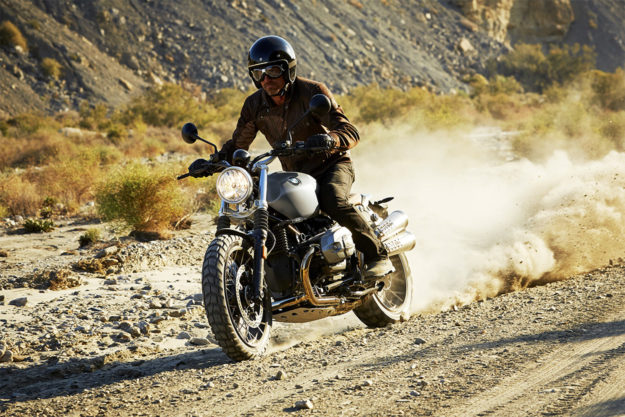
Have you guys actually taken the scrambler off-road?
Roland: It’s not a hard enduro or motocross bike, but what 95% of people do with the GS, you can do with the Scrambler too.
Ola: Laszlo Peres rode it not long ago.
Roland: Oh yes, he’s the guy who actually made the GS happen, back in the day. And he rode it in comparison to the Dakar bike from the time.
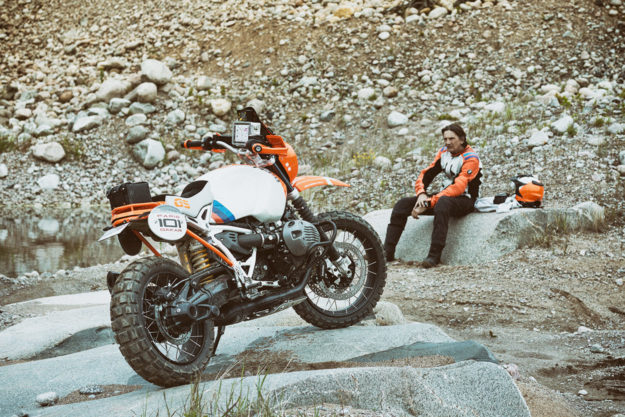
Ola: He rode the Lac Rose. He’s the father of the GS, extremely critical, very good, he knows what he’s talking about. And he rode it.
We didn’t want him too—it’s a show bike. But underneath it’s a Scrambler, it’s a normal Scrambler. But he rode it way too hard in the photo shoot. We were all: “This is not OK!”
And he came back, every round and said: “I love it, it works so damn good, maybe one click on the shock here, and one there, but basically it’s done, it’s perfect, I love it!” And then he took off again. And he just kept going, and going, and going.
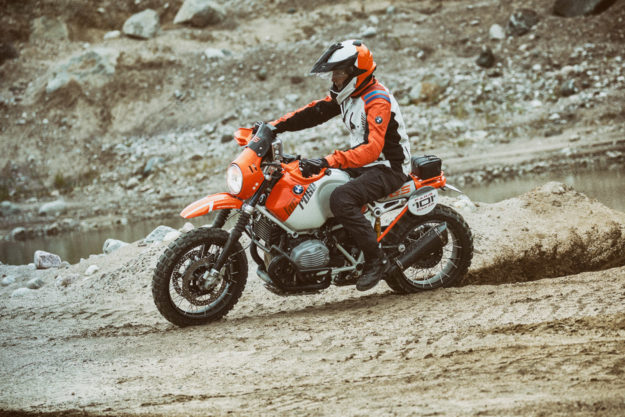
Do you think this is a viable alternative to a GS, for someone who wants a simpler, more old school dual-sport bike?
Roland: You will find if you make a direct comparison between the GS and the Scrambler, it’s a big difference. And it’s a big difference also in your head.
If you wanna go traditional, and explore the world, in a traditional way, like you wear clothes in a traditional way, then of course you would go with the Scrambler. If you wanna develop the world [laughs], and have functional clothes which work perfectly, and have all the modern technology, and these self-adjusting systems and all this stuff, then you take the GS.
So, it’s perfect—because in the world people are different. They fit perfectly next to each other, they don’t cannibalize.
Ola: My landlord is like that, he’s a total GS guy. The way he rides with his GS is like our test riders do. And, of course he says about the nineT Scrambler: “You can’t really take it off road.” Because he really takes things off road.
Then I look at my brother, he’s the total other way around. He’s ridden old bikes forever, so he sits on the new GS and he freaks out. “What are all these buttons for? It’s so powerful, and it’s so high, and now it starts to change the suspension rates, what the hell!?” Now we can cater for both, which I think is really cool.
BMW are just one of many brands tapping into the new heritage market. Is it getting crowded?
Roland: There’s not a fight between these companies. When we go to festivals, like Wheels & Waves, we meet Shun [Miyazawa, Project Manager at Yamaha USA], we go out together in the evening at Deus, we have a big table all together.
This is not a competition, this is friendship. We’re working on different projects, of course, but in general, we help to grow the market. Without Harley-Davidson, without these products, there wouldn’t be a nineT. There wouldn’t be this market at all.
So we are actually working, we are on the same side. This is so important for us, and we would never fight each other—this would be so stupid. We try to live next to each other, and there is a lot of respect in this world.
Ola: When I started in motorcycling, the big question back then was, “How do you get new people and young people into motorcycles?” That was what everyone was working on. You remember the Tricksters from Yamaha? We worked on the same kind of things.
But it wasn’t until now, when all of a sudden, through the back door, all these new guys are coming into motorcycling, through the old bikes. And no one really predicted that. We talked a lot about it, when we did the nineT. We said, “There’s a whole new generation of bikers, but they’re coming in through the back door, over here. We’ve gotta have a bike ready for them.”
It’s just really good for the whole industry, you know. Otherwise, for a long time we were just living in this vacuum where everyone thought motorcycling was gonna die. But it’s not.
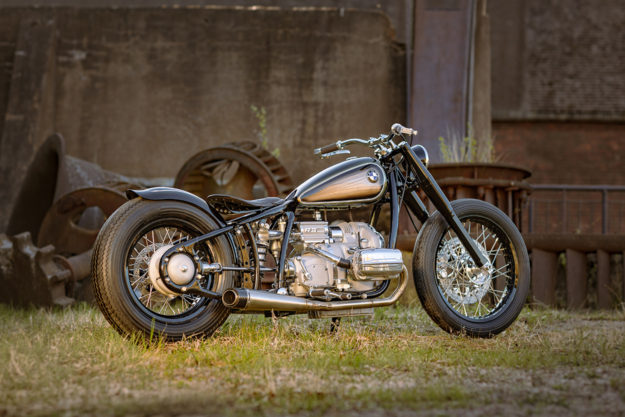
The R nineT has some serious nods to BMW’s heritage. Did this continue with the Scrambler?
Ola: It’s about simplicity. Because this is something that in the motorcycle world has really disappeared. We were joking—well, it was actually quite serious—when we did the R5 Hommage (above), because the world today has gotten so complicated. To do simple stuff is very complicated. It’s very simple to make something very complicated. But to make something simple, is very complicated.
Even when we started the Scrambler. Our normal thought, would be: “OK, we’ll make a complete new bike.” And we did a steel tank on this bike—the original nineT has an aluminum tank—and everyone said, “Great, we can do a new shape.” No, we keep the same shape, because then we have all the same geometry, it fits, everywhere. No one needs a new tank: just keep it simple.
And this is very hard today. Even in design, everyone wants to put more lines and more stuff, and we want to reduce it. It’s the hardest thing you can do.
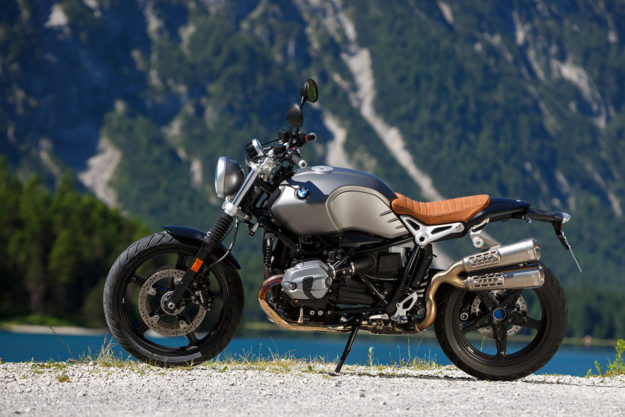
When the Scrambler came out, it was said that it would come in cheaper than the R nineT. Was that the idea straight away?
Thrass: It was a big fight, but yes. Because when you try as an engineer to improve, when you get a new project, all you need to do is look at it and say, “How can I make it better than before?” And in this case it was not about making things better. It was about keeping the same principles—that was actually quite hard.
Was that to get more guys onto the bike? Because I want an R nineT but I can’t afford it.
Ola: That was exactly the point.
Roland: We very often get the feedback, “It’s a great bike, but I can’t afford it.” This was for us a sign that we should work in this direction. What can we do to keep the bike really good, but maybe change some things to make it cheaper? And at the same time give the people the chance to upgrade?
Let’s say you buy it with a steel tank. It’s the same fixings—if one hour later you have some extra money, you can upgrade it to an aluminum tank.
Thrass: For us it was about getting the entry ticket a little bit lower, and people would maybe invest a little bit more in making the bike ‘theirs.’
And this should kick start a new wave of nineT-based customs too.
Thrass: I cannot wait to see customizers from around the world working on the Scrambler … whenever a new nineT comes up, where we didn’t endorse the custom project, but somebody did it themselves—for us it’s really cool.
Roland: Thank you for what you always do online. I always keep saying when I’m online, “Oh this is cool, this is cool, I’ll keep this, I’ll keep this.” [Laughs]. I have so many Bike EXIF pages saved.
Ola: We all have our folders with favorite bikes. My folder with favorite BMW customs, when we started the nineT, was about five or six bikes—from the whole world. That was it. But now I have like 800 or 1,000.
There’s so many good bikes. And just to see all the different things guys are doing—especially with the nineT. Last year at Glemseck, we were walking around, and it’s, like: “Did any one of you see any stock nineTs here?”
And we found one: it was in our booth.
Images courtesy of BMW Press. Our thanks to Antonia Cecchetti for arranging everything, and keeping us honest.
BMW Motorrad | Facebook | Instagram
